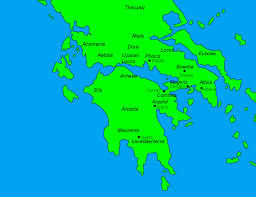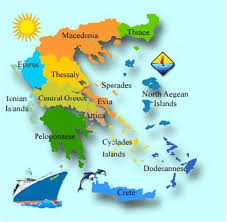The regions of ancient Greece were identified by the Greek scholars. They subdivided the Hellenic world, though the basis of rationalization remains open to doubt. In many cases, it seems that the regions of ancient Greece are curved out based on geophysical criteria.
However, in quite a few cases, this does not seem to hold true. In such cases, old tribal boundaries may have played a part.The regions in the Peloponnese and central Greece showed little change over time while the boundaries of the other areas transformed with age. The regions of ancient Greece form the basis of the modern prefecture in Greece.

Ancient Greece Regions
There are six major regions of ancient Greece, each with its own many subdivisions. In addition, there were the Greek colonies and regions of dominance in Asia Minor.
Perhaps the most ancient of all the regions of ancient Greece is Peloponnese. It forms the traditional heartland and is located in the peninsula at the South of the Balkans. Since its details can be obtained in the Iliad, it is credited with great antiquity.
It includes seven sub-regions.
1. Achaea is located in the north along the coast. This is a mountainous region.
2. The central highlands of the Peloponnese formed the Arcadia. It was somewhat remote and acted as a cultural refuge.

3. The eastern part was called Argolis and part of it was the coast.
4. The Isthmus of Corinth formed the Corinth region.
5. The flat western part was called Ellis.
6. Southeastern part was occupied by Laconia.
7. The Southwestern part formed the Messenia.
The next region of ancient Greek is central Greece. It consisted of the following
1. Aeniania is located south of Thessaly. It is present in the Valley of Spercheios River.
2. Attica lies next to the Aegean Sea.
3. Boeotia
4. Doris
5. Euboea
6. Locris
7. Malis
8. Megaris
9. Oetaea
10. Phocis
The Western part of Greece was designated as another separate region. The subdivisions are
1. Acarnania
2. Aetolia
3. Aperantia
4. Dolopia
Another region is the Thessaly. It included the following subdivisions
1. Achaea Phthiotis
2. Magnesia
3. Histiaeotis
4. Pelasgiotis
5. Perrhaebia
6. Thessaliotis
Epirus was the next region of ancient Greece.
1. Athamania
2. Chaonia
3. Dassaretia
4. Molossis
5. Thesprotia
6. Paraguay
7. Tymphaea
? Macedon including Pelagonia is the last of the regions of ancient Greece. It was one of the oldest kingdoms of the country. It is best known as the native land of Alexander the Great.
The colonies of ancient Greece:
As Greece prospered, its population increased rapidly. In fact, between 800 BC to 400BC, the total population of Greece increased from 800,000 to a total of ten to thirteen million. This obviously put a lot of strain on resources. Greeks began to establish colonies in the surrounding regions which became the next region of ancient Greece.

Asia Minor bordering the Aegean Sea and Cyprus were the first places to be colonized. Greek colonies eventually spread as far as Ukraine and Spain. The most famous Greek colonies include Naples, Marseilles, Syracuse and even Istanbul. All of these can be regarded as extensions of the regions of ancient Greece.